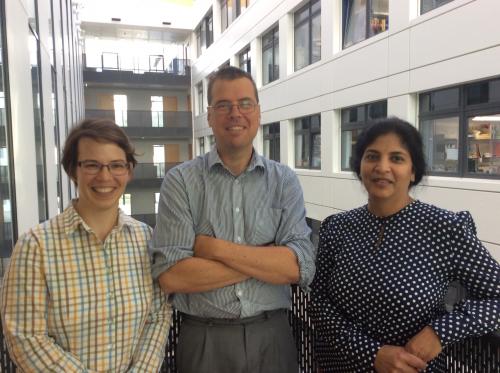
Sequence specificity of O-GlcNAc transferase uncovered
Prof. Daan van Aalten, Programme Leader at the MRC Protein Phosphorylation and Ubiquitylation Unit (MRC-PPU) based at The University of Dundee, has been focused on the function of a novel post-translational modification, O-GlcNAcylation, for the past decade. His group's recent finding concerning the protein sequences targeted by this modification represent a significant advance in this field.
O-GlcNAc transferase (OGT) glycosylates a diverse range of intracellular proteins with O-linked N-acetylglucosamine (O-GlcNAc), an essential and dynamic post-translational modification in metazoa. Dyregulation of this modification leads to defects during embryo development and has been linked to diabetes, cancer and neurodegenerative disease. Although the OGT enzyme modifies hundreds of proteins with O-GlcNAc, it is not understood how OGT achieves substrate specificity. In this study, Shalini Pathak, a postdoc in Daan's lab, used a high-throughput OGT assay on a library of peptides to demonstrate that the enzyme possesses sequence specificity. Jana Alonso, another postdoc in Daan's lab then mapped the sites of O-GlcNAc modification by ETD-mass spectrometry. Using X-ray crystallography, Marianne Schimpl, another postdoc in Daan's lab, then showed how these acceptor peptides bind to human OGT. Together this work suggests that a combination of size and conformational restriction defines sequence specificity in the −3 to +2 subsites, and defines an approximate 'sequon'. This work has several implications. Understanding the specificity of the enzyme will help researchers in the field develop more potent inhibitors that will in turn help probe the role of O-GlcNAcylation in a number of processes and disease models. Furthermore, it remains challenging to detect O-GlcNAcylation by mass spectrometry and this work paves the way for more accurate bioinformatic prediction of O-GlcNAc sites.
The results of this study have been published in Nature Structural Biology in August 2015 (click here).
O-GlcNAc transferase (OGT) glycosylates a diverse range of intracellular proteins with O-linked N-acetylglucosamine (O-GlcNAc), an essential and dynamic post-translational modification in metazoa. Dyregulation of this modification leads to defects during embryo development and has been linked to diabetes, cancer and neurodegenerative disease. Although the OGT enzyme modifies hundreds of proteins with O-GlcNAc, it is not understood how OGT achieves substrate specificity. In this study, Shalini Pathak, a postdoc in Daan's lab, used a high-throughput OGT assay on a library of peptides to demonstrate that the enzyme possesses sequence specificity. Jana Alonso, another postdoc in Daan's lab then mapped the sites of O-GlcNAc modification by ETD-mass spectrometry. Using X-ray crystallography, Marianne Schimpl, another postdoc in Daan's lab, then showed how these acceptor peptides bind to human OGT. Together this work suggests that a combination of size and conformational restriction defines sequence specificity in the −3 to +2 subsites, and defines an approximate 'sequon'. This work has several implications. Understanding the specificity of the enzyme will help researchers in the field develop more potent inhibitors that will in turn help probe the role of O-GlcNAcylation in a number of processes and disease models. Furthermore, it remains challenging to detect O-GlcNAcylation by mass spectrometry and this work paves the way for more accurate bioinformatic prediction of O-GlcNAc sites.
The results of this study have been published in Nature Structural Biology in August 2015 (click here).

